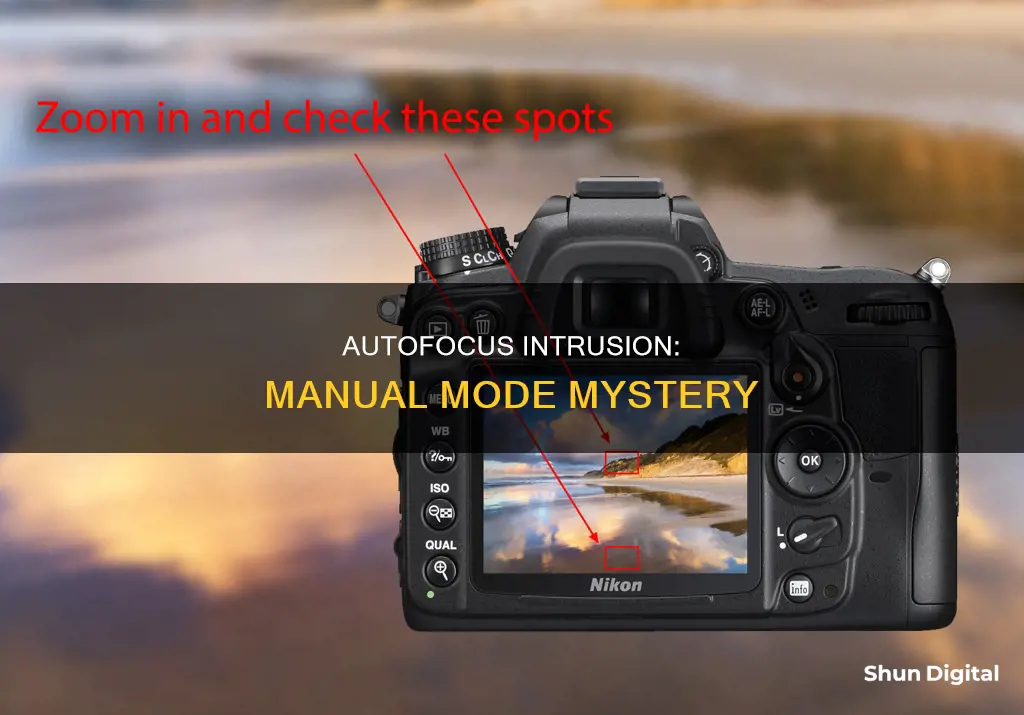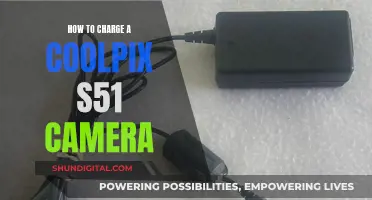
Autofocus and manual mode are two different settings on your camera. Autofocus is a feature that allows the camera to focus on a subject automatically, while manual mode gives the photographer control over the aperture and shutter speed. These settings are independent of each other, meaning you can have autofocus on while shooting in manual mode and vice versa. However, it's important to note that autofocus doesn't always get the focus right, especially in low-light conditions or when faced with a low-contrast scene. In such situations, manual focus might be a better option, allowing the photographer to have more control over the sharpness of the image.
What You'll Learn

Autofocus may still work in manual mode
To use autofocus in manual mode, simply point and shoot. The camera will focus and expose the image. However, if the shutter speed is too slow (slower than 1/ISO), you may end up with a blurry image due to camera shake.
It is worth noting that some cameras and lenses may have different autofocus behaviours in manual mode compared to auto mode. For example, the Canon EF 24-70mm II USM lens uses 'AI Servo AF' in manual mode, which continuously tracks the subject and adjusts focus as necessary. As a result, the autofocus confirmation light in the viewfinder may not illuminate, even when the subject is in focus.
Additionally, certain autofocus modes may not work in manual mode. For instance, 'AI Focus AF', which is available in auto mode on some Canon cameras, is a hybrid of 'One Shot' AF and 'AI Servo AF'. It starts in 'One Shot' mode and switches to 'AI Servo AF' if it senses that the subject is moving. However, this mode is not available in manual mode.
Unlocking Camera Raw: A Quick Guide to Reopening
You may want to see also

Autofocus can struggle in low-light conditions
In low-light conditions, a camera's autofocus may "hunt" for focus, with the lens constantly going back and forth in an attempt to focus. This can be frustrating, especially when you want to capture a moment quickly.
There are a few things you can do to improve autofocus performance in low-light conditions:
- Use a speedlight or flash commander with a built-in "AF assist" red beam. This will project a red beam onto your subject, allowing your lens to acquire focus more easily.
- Change your focus mode to AF-S (Single Servo/Single Area AF). This will help the camera acquire focus more quickly and accurately.
- Use the center AF point for more precise and reliable autofocus performance. The center AF point is typically the most sensitive and accurate due to calibration and the type of sensors used.
- Avoid focusing and recomposing. While this method can be useful, it can also introduce focusing errors. Instead, try to compose the frame as closely as possible when achieving focus.
- Target high-contrast areas. Contrast is crucial for accurate autofocus. Look for defined edges and hard lines of contrast to help the autofocus sensors achieve precise focus.
Charging Your ADT Doorbell Camera: Quick and Easy Steps
You may want to see also

Autofocus may focus on the wrong part of a scene
Autofocus systems require a certain amount of contrast in the focus area to work. This is because autofocus systems work by calculating the offset between an observed brightness pattern and a pair of miniature sensors, consisting of single rows of pixels that make up each autofocus point. If the brightness pattern is the same across the sensors, the subject is in focus. If there is a difference, the camera adjusts the lens until the brightness pattern is the same.
Therefore, if there is not enough contrast in the focus area, the autofocus system will struggle to work. This is why autofocus may focus on the wrong part of a scene. For example, if you are trying to focus on a plain wall, the camera will struggle to focus as there is no variation in brightness for the autofocus system to detect.
To fix this, you can try to find an area of contrast in the scene and place the autofocus point over it. This will allow the camera to focus more easily. You can then use the focus-and-recompose technique to adjust your framing while keeping the same focus point.
Alternatively, you can switch to manual focus mode and adjust the focus manually until the desired area is in focus. This may be easier if you are shooting a subject with low contrast, such as a plain wall.
Unraveling Camera Battery Composition: What Powers Photography?
You may want to see also

Autofocus may struggle with moving subjects
Autofocus is a fantastic feature of modern cameras, but it can struggle with fast-moving subjects. This is a common challenge for photographers, as it is more difficult to capture a moving target than a stationary one.
There are several autofocus modes available on most cameras, and choosing the right one for the situation is essential. The Continuous Focus mode, also known as AF-C or AI Servo AF, is ideal for tracking a moving subject and making constant adjustments to the focus to keep the image sharp. This mode is excellent for photographing sports events or any subject moving towards or away from the camera.
However, the autofocus may struggle to keep up with the subject if they are moving very quickly or in different directions. In these cases, the autofocus may not be able to predict which way the subject will move next, resulting in blurry or out-of-focus images.
To improve autofocus performance when shooting moving subjects, it is recommended to use a zone or multi-point focus area instead of a single-point focus. This gives the camera a larger area to track the subject and makes it easier to keep them in focus. Additionally, a fast shutter speed can help freeze the motion and improve the sharpness of the image.
Another tip is to use back-button autofocus, which combines the benefits of Continuous AF and Single AF modes. This technique allows for quick reactions and eliminates the need to change settings when switching between different types of subjects.
Practising with moving subjects and adjusting autofocus settings can help improve your skills in capturing sharp images of fast-moving targets.
Explore Lorex Camera Corridor Mode: Maximizing Your Camera's View
You may want to see also

Autofocus may not work if the lens is too close to the subject
If you are closer than the minimum focusing distance to the subject you are trying to photograph, you will not be able to focus properly. The minimum focusing distance varies by lens; in zoom lenses, it can also depend on the focal length. To check the minimum focusing distance of a lens, refer to the lens specifications or the distance printed on the lens. On the front side of the lens, the distance is indicated in meters (m) and feet (ft).
If you are in a situation where you want to get as close as possible to the subject, first get extremely close to the subject, then move away little by little to find the distance where the subject is in focus. Alternatively, you can stand further back, beyond the minimum focusing distance, to allow the lens to focus. The image won't be as close-up, but at least it will be in focus. You can always crop the image later.
Charging the Kimuvin Spy Pen Camera: A Step-by-Step Guide
You may want to see also
Frequently asked questions
Autofocus can be used in manual mode. Autofocus (AF) is a separate feature from the camera's shooting mode. The AF system can focus on the wrong part of a scene or struggle to lock on, resulting in a blurred picture.
There are two distinct autofocus modes: One-Shot AF (Canon)/Single-Servo AF (Nikon) and AI Servo AF (Canon)/Continuous-Servo AF (Nikon). One-Shot/Single-Servo is best for stationary subjects as it locks the focus setting once achieved. AI Servo/Continuous-Servo is better for tracking moving subjects as it continuously focuses the lens.
Use manual focus when you want the focus distance to remain constant, such as when shooting a sequence of photos of cars passing a spot on a racetrack. It is also the only option when the camera cannot lock on.
There is usually a switch on the lens that can be set to AF (autofocus) or MF (manual focus).







